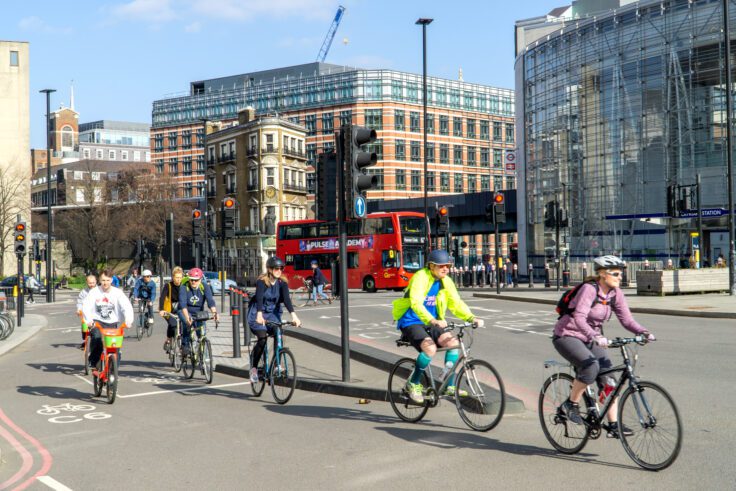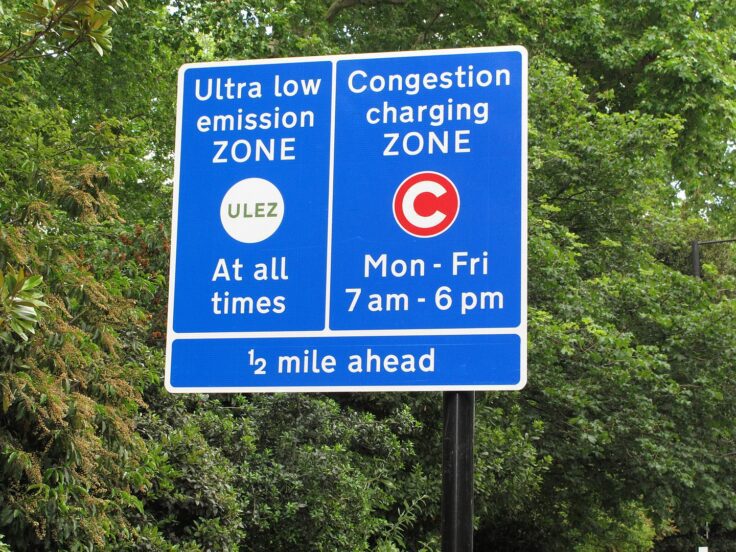There is no shortage of research on the benefits of promoting cycling in major cities. We know that there are significant environmental benefits as well as whole economic and social implications related to creating urban environments where both cycling and walking is made safer, more desirable, and more practical. We also know that comprehensive networks of protected bicycle lanes in cities can save riders time and money, compared to driving, and can encourage more people to choose to cycle for more types of trips.
Nevertheless, creating a true ‘cycling city’ is not just in the physical infrastructure of dedicated bike lanes and facilities — cities need the right mix of systems-level change and supportive policies and programs. The measures that make this possible — such as low-emission zones, parking reforms, and street space reallocation — can indeed be challenging to implement, both in terms of design, investment, and in garnering political will. But it is important for cities to understand that large-scale shifts to cycling are unlikely to happen without providing connected, protected spaces to ride and by reducing the speed and volume of private vehicles on urban roads. In the historic City of London, England, we are seeing that it is certainly possible to implement these types of sustainable mobility strategies — even in such a renowned, complex urban hub — to encourage a milestone shift in the way people commute by bike.
Cyclists now outnumbering drivers
Recent findings have indicated a welcome trend in the City of London (the square mile area that is the economic and cultural core of Greater London itself). A 2023 report from the City of London Corporation indicates that cyclists are now the single largest vehicular mode counted during peak times on area streets. At peak times, people cycling represent 40 percent of road traffic in the City and 27 percent throughout the day. Cyclist numbers are at 102 percent of pre-pandemic levels according to the report. Since 1999, the number of motorists has fallen by over 60 percent while the number of cyclists has increased by more than 380 percent. In addition, walking still remains the most popular mode of mobility in the area.

This impressive shift — while in some ways unique to the context of the City, its structure, and its resources — is also a strong case for what is possible when the right mix of policies, investment, and infrastructure is put in place to make cycling and walking the easiest, most direct way to complete most trips. Over the last decade, the use of motor vehicles has been increasingly restricted in the City as congestion and air pollution continued to climb. We can look towards actions undertaken in and around the City of London in the past two decades to understand how this shift to cycling was made possible — primarily, a focus on making it less convenient and more expensive to drive and park, while simultaneously making cycling and public infrastructure safer and more attractive.
A pioneering low emission zone
In 2019, Central London implemented an Ultra Low Emission Zone (ULEZ) that requires private and commercial cars, motorcycles, and vans to pay a £12.50 fee to enter the Zone if vehicles do not meet certain emission standards. The ULEZ works in conjunction with a London-wide Low Emission Zone (LEZ) targeting heavy vehicles, and a daily congestion charge paid by nearly all private and commercial vehicles entering Central London. The congestion charge was first introduced in 2003 to reduce trip times, improve bus service on-time rates, and encourage a shift to public transport and other non-car modes. To address issues of equity for lower-income groups, special exemptions were also given to restaurant and delivery workers, people with disabilities, and emergency vehicles. Revenues from the charges are legally allocated to public transit, cycling, and walking improvements — a critical move to secure public support and to maintain high-quality and reliability for other modes of mobility.

From the start of its LEZ strategies, London was committed to providing alternatives to driving by adding hundreds of new buses and routes to its transit networks in tandem with more investments into expanding cycling and sidewalk infrastructure. The city’s Transport for London (TfL) agency also capitalized on the lower traffic volumes that resulted from the zone-based congestion charges to claim back valuable space for new bus and cycle lanes. Data indicates that, cumulatively since 2019, the ULEZ has led to a reduction of around 800,000 tonnes of CO2 emissions from a decrease in vehicles across London over the four-year period, compared to without an ULEZ. While still an early-stage concept in many cities, the potential impacts of LEZs and traffic reduction strategies is perhaps the most tangible in London’s case, and demonstrates that reducing demand for driving and enhancing public space are the keys to encouraging more cycling. Read ITDP’s The Opportunity of Low Emission Zones report for more on LEZs and other approaches to taming traffic worldwide.
Rethinking parking and street space
While the link between on-street parking — short-term, curb-side parking spaces which can be free-of-charge or priced — and more trips being made by car might not be immediately apparent, the availability of low-cost parking often means more driving trips. The City of London, as part of its programs to reduce emissions, recognizes the link between freely available parking and more vehicles and congestion, and introduced emissions-based charges on parking to address this challenge. This program makes it more expensive for high-polluting vehicles to park in the area, nudging people to consider a non-car mode to avoid higher parking fees. As early as 2004, London also reversed its parking policy requirements, eliminating the previous minimums it had and adopting maximums on off-street parking supplied by new developments in the metropolitan area. Such reshaping of parking policies and supply is critical to reclaiming urban space in a city as dense as London, and ultimately allows more room for transit-oriented development.
The City has also placed a stronger focus on implementing complete streets where roads throughout central areas of the city are re-designed to allow more space and ease-of-access for pedestrians and cyclists, while addressing key issues of wayfinding and safety. The Mayor of London’s office has developed a comprehensive Vision for Cycling Plan for the city as well which, as of 2013, includes funding of £913 million for more integrated cycling infrastructure. The plan includes several main outcomes for implementing street spaces that: provide bike facilities that better connect to the London Underground, rails, and bus routes; improvements to intersection designs with specific safety measures; actions to encourage and normalize cycling as a reliable transport mode; and enhancements to open spaces, greenways, and parks.
Inspiration for – and from – other global cities
London’s work on cycling and sustainable mobility has even inspired changes in other cities. London’s ULEZ, for example, has directly influenced the current Mayoral Administration of Bogotá, Colombia. The Mayor of Bogotá has referenced her knowledge of London’s efforts to inform the city’s own Zonas Urbanas por un Mejor Aire (Zone for Better Air, or ZUMA) strategies. The ZUMA aims to improve air quality in highly polluted areas of the city where vulnerable communities are the most exposed to pollution and dangerous road conditions. The overarching goals of the ZUMA are to: reduce emissions from both industry and transport alike, encourage more active mobility, increase green areas, reduce pollution exposure, and improve the health of all of Bogotá’s residents.

At the same time that cities like Bogotá are gaining inspiration from London, there are also models of progress in other places that the City of London can learn from to further its efforts. In Fortaleza, Brazil, for example, on-street parking spaces are efficiently priced, with revenue from the parking programs going directly to support the city’s bikeshare system and bicycle infrastructure. Pricing on-street parking based on demand can also reduce the need to provide as much on-street parking for cars, and enable cities to re-allocate precious curb space to more efficient and equitable uses like bicycle lanes or bus lanes that can serve more people. Similarly, in Mexico City, an advanced multi-space parking meter program for on-street spaces launched in 2012 that helps to generate revenue for improvements to pedestrian and cycling infrastructure, while also providing better management of traffic congestion. Continuing to reform parking policies in the City of London has immense potential to create an area where cycling may even be a primary mode of transport for most commuters.
In Barcelona, Spain the city’s innovative ‘Superblock’ concept has also garnered much interest from global urban planners looking to reduce car usage and improve connections in dense neighborhoods. The concept is focused on diverting vehicle traffic primarily to outer streets, freeing up through-street space for other uses. Intersections are transformed to become spaces for neighbors to gather, and vehicle lanes become low-speed thoroughfares for pedestrians and cyclists. These conditions make trips by walking or cycling within neighborhoods the most convenient option, whereas trips with motor vehicles are made much less direct. With nearly 100 kilometers of bicycle lanes implemented in the last six years, a reported 90 percent of Barcelona’s population now live near a cycle lane and cycling trips went up by 30 percent around Superblock pilots, making the choice to cycle easy, logical, and safe. While not without its challenges, Barcelona’s Superblocks certainly offer inspiration for other historic cities, London included, to take their visions for sustainable mobility even further.
The City of London’s newsworthy cycling transformation is ultimately a very promising model for all that is possible when funding, policy, and public and political will intersect to change transport environments and behaviors for the better. While many cities certainly do not have the same robust political or economic resources available as London does, a number of the city’s approaches to reshaping urban mobility can still be adapted for diverse geographic and cultural contexts. To combat the climate crisis and ensure more transport equity and sustainability for future generations, all cities need to recognize that change is possible — and urgently needed.

